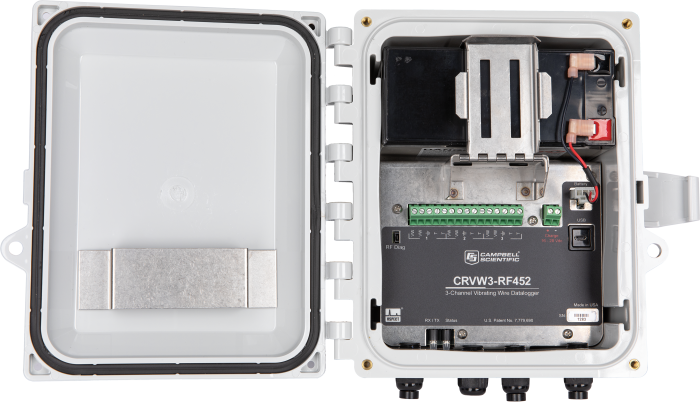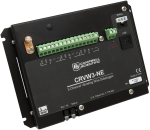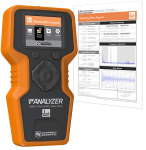概览
CRVW3 是一种完备的低成本的3通道振弦数据采集器,配备VSPECT™ 专利技术。设计用作独立的数据采集器,或某个大型数据采集器网络中的一个可靠组件。CRVW3 出厂时配备电源、通讯和防护机箱,适合您的监测需求。
Learn about our patented VSPECT® spectral-analysis technology at our VSPECT® Essentials web resource.
The dynamic vibrating-wire measurement technique is protected under U.S. Patent No. 8,671,758, and the vibrating-wire spectral-analysis technology (VSPECT®) is protected under U.S. Patent No. 7,779,690.
优势与特点
- Reads and stores data from one to three vibrating wire sensors
- Charge regulator included for solar panel connection
- Enclosure rated to IP66
- Simple programming interface
- Integrated rechargeable or alkaline battery options
- Compatible with many existing Campbell Scientific data acquisition networks
- PakBus router/radio repeater capabilities
图像







技术说明
CRVW3 使用专利的振弦频谱分析技术 (VSPECT™),可能对振弦传感器提供最佳的测量。VSPECT™ 观测输入的传感器信号,实施傅立叶变换和频谱分析,通过识别在可接受范围的最强信号,来确定传感器的频率,无视外部的噪声。
CRVW3 提供下列数据:共振传感器频率、用于温度计算的热敏电阻阻值、以及用于确认频率测量有效性的诊断值。
注:CRVW3 需要 Device Configuration Utility (DevConfig) 2.10 或更高版本。当使用电台选项时,CRVW3 需要使用 LoggerNet v 4.3 或更高版本。
产品规格
| -NOTE- |
|
| Operating Temperature Range |
|
| Processor | ST ARM CORTEX-M4 (32-bit with hardware FPU, running at 144 MHz) |
| Data Storage | 16 MB serial flash, up to 420,000 records (single channel), up to 160,000 records (3 channels) |
| Real-Time Clock Accuracy | ±3 min. per year |
| Measurement Interval Range | 1 s to 1 day |
| USB Micro B | Direct connect to PC (supplies power for configuration and data collection), 2.0 full speed, 12 Mbps |
| Configuration | Software configurable, no programming required |
| Compliance | RoHS |
| Warranty | One year against defects in materials and workmanship |
| Weatherproof Enclosure Rating | NEMA 4X (IP66) with proper use of cable entry points |
| Enclosure Mounting | Stainless-steel universal mount for pole/wall mount (optional) or plastic mounting tabs (included) |
| Static Vibrating Wire Measurements | Supported |
| Enclosure Dimensions | 24.1 x 22.9 x 14.0 cm (9.5 x 9.0 x 5.5 in.) |
| Weight |
|
Power |
|
| Charge Terminal | 16 to 28 Vdc (from solar panel or dc power converter) |
| Battery Options | Rechargeable 7 Ah or 8 D-cell alkaline |
| Current Drain |
|
Measurements |
|
| Channel Count | 3 vibrating wire (VW) and 3 thermistor/RTD (temperature) measurements |
| Measurement Speed | 1 s per sensor (VW and temperature) |
Measurements - Vibrating Wire |
|
| Measurement Excitation Options | 2 V (±1 V), 5 V (±2.5 V),12 V (±6 V) |
| Measurement (Frequency) Resolution | 0.001 Hz RMS (-40° to +70°C) |
| Time-series Basic Resolution | 24-bit ADC |
| Measurement Accuracy | ±0.005% of reading (-40° to +70°C) |
| Measurement Method | VSPECT® (Spectral Analysis), U.S. Patent No. 7,779,690, includes diagnostic data |
Measurements - Temperature (Resistance) |
|
| -NOTE- | Thermistor or RTD resistance can be scaled to Temperature (Deg C) per manufacturer specifications. The resulting temperature can be used as a correction factor for the sensor’s output. |
| Measurement Method | Half-bridge ratiometric, 24-bit ADC, built-in completion resistor 4.99 kΩ 0.1% |
| Thermistor Precision | 0.020 Ω RMS @ 3000 Ω (~0.00015 °C RMS for most vibrating wire thermistors) |
| Accuracy | ±0.15% of reading (-40° to +70°C) |
-RF407 Option |
|
| Internal Radio Description | 5 to 250 mW, user selectable; 902 to 928 MHz license-free band, frequency hopping spread-spectrum radio |
| Radio Repeater | Devices with the -RF407 option can be set up as a radio repeater. |
| Where Used | US, Canada |
| Compliance Information |
|
-RF412 Option |
|
| Internal Radio Description | 5 to 250 mW, user selectable; 915 to 928 MHz license-free band, frequency hopping spread-spectrum radio |
| Radio Repeater | Devices with the -RF412 option can be set up as a radio repeater. |
| Where Used | Australia |
| Compliance Information |
|
-RF422 Option |
|
| Internal Radio Description | 2 to 25 mW, user selectable; 863 to 870 MHz license-free band, frequency hopping spread-spectrum radio |
| Where Used | Europe and some of Asia (ETSI) |
| EU Conformity | View the EU Declaration of Conformity in the Documents section of the web page. |
-RF452 Option |
|
| Internal Radio Description | 10 to 1,000 mW, user selectable; 902 to 928 MHz license-free band, frequency hopping spread-spectrum radio |
| Radio Repeater | Devices with the -RF452 option can be set up as a radio repeater. |
| Where Used | US, Canada, Australia |
| Compliance Information |
|
兼容性
Sensors
The CRVW3 Vibrating Wire Datalogger is capable of measuring the most common vibrating wire sensors including, but not limited to, strain gages, piezometers, pressure transducers, tiltmeters, crackmeters, and load cells. The CRVW3 has three sensor inputs; each sensor input includes a vibrating wire sensor connection and a thermistor connection. The channels are easily configured for traditional sensors. Individual channels can be adjusted to read only the vibrating wire sensor, or they may be turned off completely.
Network Considerations
The CRVW3 can be ordered with several wireless communication options. The following table illustrates wireless communications compatibilities in terms of networks.
CRVW3 Network Compatibility
| RF400a | RF401A RF401a RF430a |
RF407 | RF411A RF410a RF411a RF431a |
RF412 | RF416 RF432a RF415a |
RF422 | RF450a RF451a RF452 |
|
| CRVW3-RF407 |  |
|||||||
| CRVW3-RF412 |  |
|||||||
| CRVW3-RF422 |  |
|||||||
| CRVW3-RF451 |  |
|||||||
| CRVW3-RF452 |  |
Notes: aRetired product; no longer available.
Enclosure Considerations
The CRVW3 comes in a package designed for field deployment. The electronics, battery, and electrical connections are all contained within the enclosure. The CRVW3 is supplied with a basic mounting kit, or a metal universal mounting bracket can be added to facilitate installation on a post or wall.
Power Considerations
The CRVW3 can be ordered with either a rechargeable battery or a D-cell alkaline battery pack. When the rechargeable battery is used, the CRVW3 can be easily wired to a solar panel, and the rechargeable battery will be charged using the built-in regulator on the CRVW3.
相关技术文档
规约
- CRVW3 EU Declaration of Conformity
- CRVW3 UK Declaration of Conformity
- CRVW3-RF407 FCC Supplier Declaration of Conformity and FCC Statement
- CRVW3-RF422 and CRVW3-NE-RF422 UK Declaration of Conformity
- RF427 Brazilian Certificate of Conformity
- CRVW3-RF451 FCC Supplier Declaration of Conformity and FCC Statement
下载
Device Configuration Utility v.2.29 (54 MB) 15-11-2023
A software utility used to download operating systems and set up Campbell Scientific hardware. Also will update PakBus Graph and the Network Planner if they have been installed previously by another Campbell Scientific software package.
Supported Operating Systems:
Windows 11 or 10 (Both 32 and 64 bit)
常见问题解答
CRVW3: 11
展开全部收起全部
-
The CRVW3 takes approximately 1 s to measure the vibrating wire sensor and thermistor. If all three channels are measuring sensors, the CRVW3 takes approximately 3 s to measure the sensors before it is ready to begin the cycle again.
-
Yes. The batteries can be switched at any time between the D-cell battery option and the rechargeable battery option.
-
The communications options (such as –RF451) reflect how the CRVW3 is built during the manufacturing process. After a CRVW3 is ordered with a specific communications option, it retains that option. It is possible to turn off the wireless communications, and the CRVW3 can be deployed as a stand-alone data logger.
-
Yes. The CRVW3 can be used as a stand-alone data logger. If the CRVW3 is not connected to a network, data is collected by connecting directly to the CRVW3 (via USB) or through a simple wireless connection, as outlined in the manual.
-
No. The CRVW3 has built-in memory and can be configured in a variety of ways. It can measure data frequently and communicate the data at a slower rate (for example, measure every 10 minutes and communicate the results once per day). The CRVW3 can also communicate data after each measurement is taken. The ability to configure the communications on a network to an application's specific needs allows the user to better manage the power consumption on the CRVW3, as well as on the base data logger.
-
No. The CRVW3 is designed to be a simple, quickly deployed system with minimal modifications. The simple design of the CRVW3 does not enable it for use with multiplexers. When an application requires multiplexers, consider using a CR6 Measurement and Control Datalogger instead.
-
Not much. The CRVW3 needs to be configured, installed, and wired at the site. These steps have been outlined in the Quick Deploy guide that ships with the CRVW3 and is also available for download on this website. The manual is a more detailed resource to address any installation questions.
-
Yes. The CRVW3 is a PakBus device that can communicate with other PakBus data loggers. The neighbor data logger requires a radio device compatible with the CRVW3 radio option. If a CRVW3-RF451 model is used, the neighbor device needs to have an RF450 or RF451 radio installed to enable wireless communications. After connecting to the first neighbor, PakBus routing can be used to reach other PakBus devices available to that neighbor via any type of active communications link (TCP/IP, WiFi, etc.) Network Planner is a tool within LoggerNet used to design a network and explore how devices communicate.
-
There are multiple communication options depending on how the CRVW3 is ordered. All CRVW3 devices can communicate data and be configured using the built-in USB connection. If a CRVW3 is ordered with a wireless communication option, it can also communicate the data wirelessly to a PC or another data logger.
-
A practical maximum is to connect one multiplexer per every two control terminals on the data logger. Control terminals can be shared between multiplexers to increase the number of connected multiplexers. Sharing terminals, however, requires more complex wiring and programming. Users who would like to connect more than one multiplexer per every two control terminals are advised to contact a sales or support engineer at Campbell Scientific for assistance.
文章和新闻发布
博客文章
-
A Closer Look: Resolving Dam Data Discrepancies

05-03-2024 作者: Eric Schmidt -
Get the Most out of VSPECT®

22-08-2023 作者: Jacqalyn Maughan -
Use VSPECT® to Verify: Bad Sensors or Bad Data?

06-04-2023 作者: Jacqalyn Maughan














